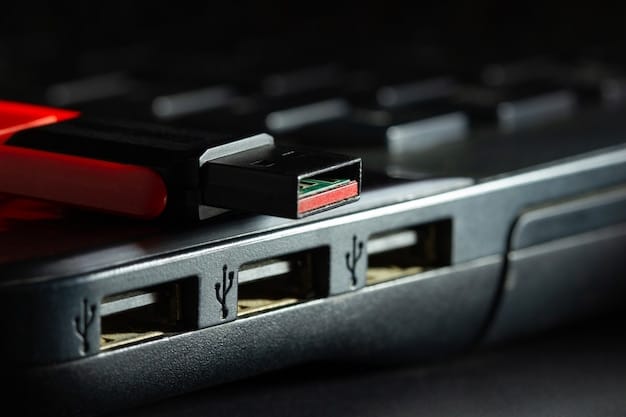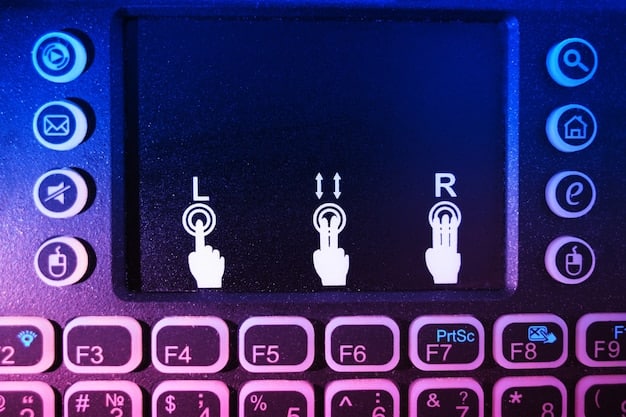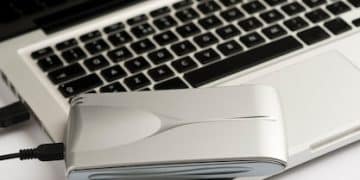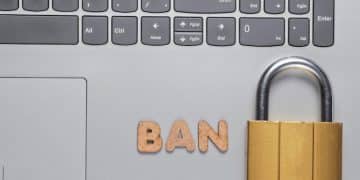How to Back Up Your Computer to an External Hard Drive in 3 Hours

Backing up your entire computer to an external hard drive within 3 hours involves selecting the right drive, using efficient backup software, and optimizing settings for speed, ensuring your data is safe and recoverable.
Want to safeguard your precious memories, important documents, and entire digital life? Learning how to back up your entire computer to an external hard drive in 3 hours is a smart move. This guide will walk you through the process step-by-step.
Choosing the Right External Hard Drive
Selecting the right external hard drive is the first step in ensuring a quick and reliable backup of your computer’s data. The type, speed, and capacity of the drive can significantly impact the backup process.
HDD vs. SSD: Which is Faster?
When it comes to speed, Solid State Drives (SSDs) generally outperform Hard Disk Drives (HDDs). SSDs have no moving parts, allowing for faster data transfer rates.
Capacity Considerations
Ensure the external drive has enough capacity to store all your data. A good rule of thumb is to get a drive with at least twice the storage capacity of your computer’s internal drive.
- HDD (Hard Disk Drive): More affordable, larger storage capacities, but slower data transfer rates.
- SSD (Solid State Drive): Faster data transfer speeds, more durable, but typically more expensive and smaller storage capacities for the price.
- Connection Type (USB 3.0/3.1/3.2 or Thunderbolt): Opt for newer USB generations or Thunderbolt for faster data transfer speeds.
Selecting an SSD over an HDD can significantly reduce the backup time, especially for large amounts of data. Also ensure that the drive has a fast connection type to your computer, such as USB 3.0 or Thunderbolt, for optimal speeds.

Step-by-Step Guide to Backing Up Your Computer
Now that you’ve selected the right external hard drive, it’s time to start the backup process. Follow these steps to back up your entire computer to an external hard drive in 3 hours or less.
Using Windows Backup and Restore
Windows has a built-in backup tool that’s effective for creating system images and backing up files. Access it via the Control Panel.
Using macOS Time Machine
macOS users can leverage Time Machine to automate the backup process. Time Machine creates incremental backups, making it easy to restore specific files or an entire system.
- Connect the External Drive: Plug the external hard drive into your computer.
- Choose Backup Software: Select either a built-in utility (like Windows Backup or macOS Time Machine) or a third-party backup solution.
- Configure Backup Settings: Choose what to back up (entire system or specific files), set a backup schedule, and select the external drive as the destination.
- Start the Backup: Initiate the backup process and monitor its progress.
Configuring your backup settings properly ensures that all critical data is included in the backup. Regular incremental backups can save time and storage space, ensuring that you always have a recent copy of your data.
Optimizing Backup Settings for Speed
To complete the backup process in under 3 hours, optimizing your backup settings is critical. Certain settings can significantly impact the time it takes to back up your entire computer to an external hard drive.
Excluding Unnecessary Files
Exclude temporary files, cache data, and other non-essential files from the backup. This reduces the amount of data that needs to be transferred.
Compression and Encryption
While compression can save space, it can also slow down the backup process. Encryption adds security but can also increase backup time. Find a balance that meets your needs.

- Exclude System Files: Operating system files rarely change, so exclude them unless you’re performing a full system image backup.
- Adjust Compression Level: Lower compression levels can speed up the process but will result in larger backup files.
- Schedule Backups: Schedule backups during off-peak hours to avoid slowing down your computer during use.
Adjusting these settings according to your specific needs can help streamline the backup process and reduce the overall time. Regular monitoring ensures that the backup remains efficient and effective.
Troubleshooting Common Backup Issues
Sometimes, the backup process may not go as smoothly as planned. Here are some common issues you might encounter, and how to troubleshoot them when trying to back up your entire computer to an external hard drive.
Dealing with Slow Backup Speeds
Slow backup speeds can be caused by several factors, including a slow external drive, a poor connection, or resource-intensive processes running in the background.
Addressing Backup Errors
Backup errors can range from file corruption to insufficient disk space. Diagnose the issue and take appropriate action.
- Check the Connection: Ensure the external drive is securely connected to your computer.
- Close Unnecessary Programs: Close any programs that are using a lot of system resources.
- Defragment Your Hard Drive: Defragmenting the hard drive can help improve read/write speeds.
By systematically addressing these common issues, you can improve the reliability and speed of your backup process, ensuring that your data is safe and accessible when needed.
Choosing the Right Backup Software
Selecting the right backup software is crucial for an efficient and reliable backup process. The software should be user-friendly, offer the necessary features, and be compatible with your operating system. You have many options for software to back up your entire computer to an external hard drive.
Built-in Options: Windows Backup and macOS Time Machine
Both Windows and macOS come with built-in backup utilities that are easy to use and effective for basic backups. These include Windows Backup and Restore and macOS Time Machine.
Third-Party Backup Solutions
For more advanced features and customization options, consider using third-party backup software. Several reputable programs are available, each with its own strengths and weaknesses.
- Ease of Use: Choose software with a user-friendly interface that’s easy to navigate.
- Features: Look for features like incremental backups, scheduling, and encryption.
- Compatibility: Ensure the software is compatible with your operating system and external drive.
By carefully evaluating the different backup software options, you can choose the one that best meets your needs and provides a seamless backup experience.
Verifying Your Backup
After completing the backup process, it’s important to verify that the backup was successful and that your data is intact. This ensures that you can restore your data without issues when the time comes. Regularly verifying is crutial after you back up your entire computer to an external hard drive.
Performing a Test Restore
Perform a test restore by selecting a few files from the backup and restoring them to a different location on your computer. This confirms that the backup is working and that you can access your files.
Checking for Errors
Check the backup logs for any errors or warnings that may indicate issues with the backup. Address any issues promptly to prevent data loss.
- Check File Integrity: Verify that the restored files are identical to the original files.
- Review Backup Logs: Look for any error messages or warnings in the backup logs.
- Regularly Update Your Backup Software: Keep your backup software up to date to ensure compatibility and security.
By taking these steps to verify your backup, you can have confidence that your data is safe and recoverable.
| Key Point | Brief Description |
|---|---|
| 💾 Select the Right Drive | Choose between HDD and SSD based on speed and capacity needs. |
| ⚙️ Optimize Backup Settings | Exclude unnecessary files and adjust compression for faster backups. |
| ✔️ Verify Your Backup | Perform a test restore to ensure data integrity. |
| 🛡️ Choose Backup Software | Select software with the necessary features and ease of use. |
General Questions
▼
Ideally, you should back up your computer regularly, depending on how frequently your data changes. For most users, a weekly backup is sufficient. However, if you work with critical data daily, consider backing up daily or even multiple times a day.
▼
Yes, cloud storage is a viable alternative for backing up your computer. It offers the advantage of offsite storage, protecting your data from physical damage to your home or office. However, it requires a reliable internet connection and may incur subscription costs.
▼
If your external hard drive fails, you will lose the data stored on it. This is why it’s crucial to have multiple backups, such as both an external hard drive and cloud storage, to ensure redundancy and protect against data loss.
▼
The process of restoring your computer from an external hard drive depends on the backup software you used. Generally, you will need to boot your computer from the backup drive or use a recovery disk, then follow the prompts to restore your system or specific files.
▼
While it’s convenient to leave your external hard drive connected, it’s not recommended. Doing so can expose the drive to power surges, malware, and other potential risks. It’s best to connect the drive only when you’re performing a backup or restore.
Conclusion
Backing up your computer to an external hard drive is a critical step in protecting your valuable data. By choosing the right drive, optimizing your backup settings, and following the steps outlined in this guide, you can back up your entire computer to an external hard drive in 3 hours or less. Regular backups ensure that your data remains safe, secure, and accessible when you need it most.





